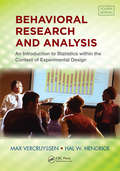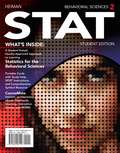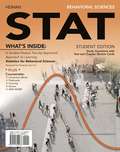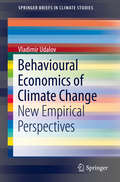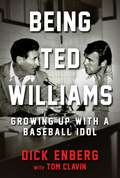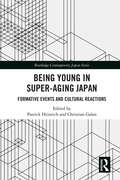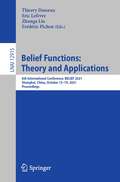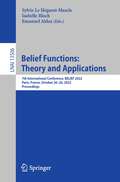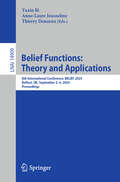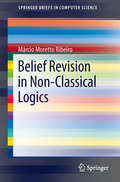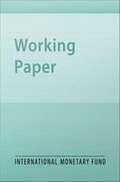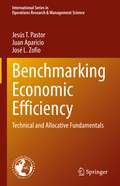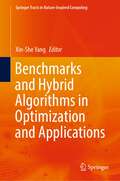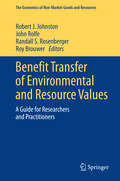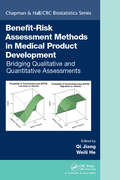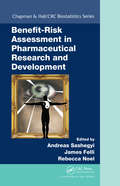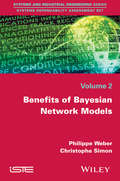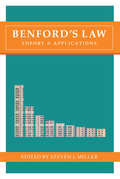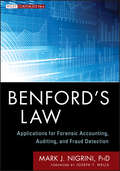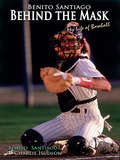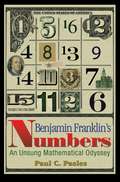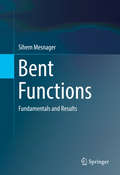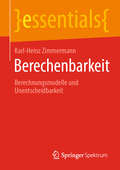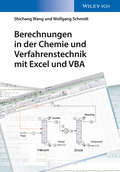- Table View
- List View
Behavioral Research and Analysis: An Introduction to Statistics within the Context of Experimental Design, Fourth Edition
by Max Vercruyssen Hal W. HendrickNow in its fourth edition, Behavioral Research and Analysis: An Introduction to Statistics within the Context of Experimental Design presents an overview of statistical methods within the context of experimental design. It covers fundamental topics such as data collection, data analysis, interpretation of results, and communication of findings
Behavioral Sciences STAT (New, Engaging Titles from 4LTR Press)
by Gary Heiman4LTR Press solutions give students the option to choose the format that best suits their learning preferences. This option is perfect for those students who focus on the textbook as their main course resource.
Behavioral Sciences Stat
by Gary W. HeimanSTAT FOR THE BEHAVIORAL SCIENCES is an engaging and accessible solution to accommodate the diverse lifestyles of today's learners at a value-based price. Each chapter begins with a list of previously discussed concepts that students should review. Throughout each chapter, important points are emphasized by a "REMEMBER" summary reminder set off from the text. Summary tables and sections appear regularly and help organize and integrate the separate steps discussed in previous sections.
Behavioural Economics of Climate Change: New Empirical Perspectives (Springerbriefs In Climate Studies)
by Vladimir UdalovThis book investigates various kinds of climate change mitigation behaviour, which range from a general support of environmental policy to concrete energy-saving activities, in selected countries. Drawing on extensive national and international survey data, the analysis has the following main objectives: to identify potential determinants of individuals’ renewable energy support, and to analyse the impact of experiences with natural disasters on individuals’ choice between economic growth and environmental protection. Moreover, it examines the role of environmental motivations behind direct daily energy-saving behaviour. The empirical results reveal that various types of climate change mitigation behaviour are not only driven by a mixture of environmental and non-environmental/economic motivations but also depend on external circumstances such as natural disasters. Since CO2 emission dynamics stem to some extent from the choices people make every day in their roles as consumers, investors and citizens, the new findings presented are also valuable from a policy perspective.
Being Ted Williams: Growing Up with a Baseball Idol
by Tom Clavin Dick EnbergAugust 30, 2018 marks the 100th birthday of the former Boston Red Sox outfielder and baseball legend. In Being Ted Williams, esteemed sportscaster Dick Enberg offers a series of personal anecdotes that loosely follow Ted's life from his childhood in San Diego, to his fun teenage years playing in the Pacific Coast League, his glorious yet frustrating Red Sox career, his heroic actions as a fighter pilot in two wars (as John Glenn's favorite wing-man), and his post-career years leading to his heart-rending appearance at age eighty at the 1999 All-Star Game. Though other books have recounted Williams's career, none have done so through the eyes of someone like Enberg, who followed Ted's career as just a young boy, trying to emulate his classic swing, then as a broadcaster, and finally as a friend, when the two men could enjoy numerous get-togethers until Ted's passing in 2002. Enberg also weaves in personal stories and commentary on what it means to be a hero from other legendary sports figures, such as Bobby Knight, Vin Scully, Bill Walton, and many more. Being Ted Williams makes the perfect gift for the baseball fan looking for a unique perspective on one of the sport's greatest legends through the lens of one of the best broadcasters in the game's history.
Being Young in Super-Aging Japan: Formative Events and Cultural Reactions (Routledge Contemporary Japan Series)
by Christian Galan Patrick HeinrichJapan is not only the oldest society in the world today, but also the oldest society to have ever existed. This aging trend, however, presents many challenges to contemporary Japan, as it permeates all areas of life, from the economy and welfare to social cohesion and population decline. Nobody is more affected by these changes than the young generation. This book studies Japanese youth in the aging society in detail. It analyses formative events and cultural reactions. Themes include employment, parenthood, sexuality, but also art, literature and language, thus demonstrating how the younger generation can provide insights into the future of Japanese society more generally. This book argues that the prolonged crisis resulted in a commonly shared destabilization of thoughts and attitudes and that this has shaped a new generation that is unlike any other in post-war Japan. Presenting an inter-disciplinary approach to the study of the aging trend and what it implies for young Japanese, this book will be useful to students and scholars of Japanese culture and society, as well cultural anthropology and demography.
Belief Functions: 6th International Conference, BELIEF 2021, Shanghai, China, October 15–19, 2021, Proceedings (Lecture Notes in Computer Science #12915)
by Frédéric Pichon Thierry Denœux Eric Lefèvre Zhunga LiuThis book constitutes the refereed proceedings of the 6th International Conference on Belief Functions, BELIEF 2021, held in Shanghai, China, in October 2021. The 30 full papers presented in this book were carefully selected and reviewed from 37 submissions. The papers cover a wide range on theoretical aspects on mathematical foundations, statistical inference as well as on applications in various areas including classification, clustering, data fusion, image processing, and much more.
Belief Functions: 7th International Conference, BELIEF 2022, Paris, France, October 26–28, 2022, Proceedings (Lecture Notes in Computer Science #13506)
by Isabelle Bloch Sylvie Le Hégarat-Mascle Emanuel AldeaThis book constitutes the refereed proceedings of the 7th International Conference on Belief Functions, BELIEF 2022, held in Paris, France, in October 2022.The theory of belief functions is now well established as a general framework for reasoning with uncertainty, and has well-understood connections to other frameworks such as probability, possibility, and imprecise probability theories. It has been applied in diverse areas such as machine learning, information fusion, and pattern recognition. The 29 full papers presented in this book were carefully selected and reviewed from 31 submissions. The papers cover a wide range on theoretical aspects on mathematical foundations, statistical inference as well as on applications in various areas including classification, clustering, data fusion, image processing, and much more.
Belief Functions: 8th International Conference, BELIEF 2024, Belfast, UK, September 2–4, 2024, Proceedings (Lecture Notes in Computer Science #14909)
by Yaxin Bi Thierry Denoeux Anne-Laure JousselmeThis book constitutes the refereed proceedings of the 8th International Conference on Belief Functions, BELIEF 2024, held in Belfast, UK, in September 2–4, 2024. The 30 full papers presented in this book were carefully selected and reviewed from 36 submissions. The papers cover a wide range on theoretical aspects on Machine learning; Statistical inference; Information fusion and optimization; Measures of uncertainty, conflict and distances; Continuous belief functions, logics, computation.
Belief Revision in Non-Classical Logics (SpringerBriefs in Computer Science)
by Márcio Moretto RibeiroSince the advent of the Semantic Web, interest in the dynamics of ontologies (ontology evolution) has grown significantly. Belief revision presents a good theoretical framework for dealing with this problem; however, classical belief revision is not well suited for logics such as Description Logics. Belief Revision in Non-Classical Logics presents a framework which can be applied to a wide class of logics that include - besides most Description Logics such as the ones behind OWL - Horn Logic and Intuitionistic logic, amongst others. The author also presents algorithms for the most important constructions in belief bases. Researchers and practitioners in theoretical computing will find this an invaluable resource.
Benchmark Priors Revisited: On Adaptive Shrinkage and the Supermodel Effect in Bayesian Model Averaging*
by Martin Feldkircher Stefan ZeugnerA report from the International Monetary Fund.
Benchmarking Economic Efficiency: Technical and Allocative Fundamentals (International Series in Operations Research & Management Science #315)
by Juan Aparicio Jesús T. Pastor José L. ZofíoThis book unifies and extends the definition and measurement of economic efficiency and its use as a real-life benchmarking technique for actual organizations. Analytically, the book relies on the economic theory of duality as guiding framework. Empirically, it shows how the alternative models can be implemented by way of Data Envelopment Analysis. An accompanying software programmed in the open-source Julia language is used to solve the models. The package is a self-contained set of functions that can be used for individual learning and instruction. The source code, associated documentation, and replication notebooks are available online. The book discusses the concept of economic efficiency at the firm level, comparing observed to optimal economic performance, and its decomposition according to technical and allocative criteria. Depending on the underlying technical efficiency measure, economic efficiency can be decomposed multiplicatively or additively. Part I of the book deals with the classic multiplicative approach that decomposes cost and revenue efficiency based on radial distance functions. Subsequently, the book examines how these partial approaches can be expanded to the notion of profitability efficiency, considering both the input and output dimensions of the firm, and relying on the generalized distance function for the measurement of technical efficiency. Part II is devoted to the recent additive framework related to the decomposition of economic inefficiency defined in terms of cost, revenue, and profit. The book presents economic models for the Russell and enhanced graph Russell measures, the weighted additive distance function, the directional distance function, the modified directional distance function, and the Hölder distance function. Each model is presented in a separate chapter. New approaches that qualify and generalize previous results are also introduced in the last chapters, including the reverse directional distance function and the general direct approach. The book concludes by highlighting the importance of benchmarking economic efficiency for all business stakeholders and recalling the main conclusions obtained from many years of research on this topic. The book offers different alternatives to measure economic efficiency based on a set of desirable properties and advises on the choice of specific economic efficiency models.
Benchmarks and Hybrid Algorithms in Optimization and Applications (Springer Tracts in Nature-Inspired Computing)
by Xin-She YangThis book is specially focused on the latest developments and findings on hybrid algorithms and benchmarks in optimization and their applications in sciences, engineering, and industries. The book also provides some comprehensive reviews and surveys on implementations and coding aspects of benchmarks. The book is useful for Ph.D. students and researchers with a wide experience in the subject areas and also good reference for practitioners from academia and industrial applications.
Benefit Transfer of Environmental and Resource Values: A Guide for Researchers and Practitioners (The Economics of Non-Market Goods and Resources #14)
by John Rolfe Roy Brouwer Robert J. Johnston Randall S. RosenbergerThis book provides a comprehensive review of environmental benefit transfer methods, issues and challenges, covering topics relevant to researchers and practitioners. Early chapters provide accessible introductory materials suitable for non-economists. These chapters also detail how benefit transfer is used within the policy process. Later chapters cover more advanced topics suited to valuation researchers, graduate students and those with similar knowledge of economic and statistical theory and methods. This book provides the most complete coverage of environmental benefit transfer methods available in a single location. The book targets a wide audience, including undergraduate and graduate students, practitioners in economics and other disciplines looking for a one-stop handbook covering benefit transfer topics and those who wish to apply or evaluate benefit transfer methods. It is designed for those both with and without training in economics
Benefit-Risk Assessment Methods in Medical Product Development: Bridging Qualitative and Quantitative Assessments (Chapman & Hall/CRC Biostatistics Series)
by Qi Jiang and Weili HeGuides You on the Development and Implementation of B–R Evaluations Benefit–Risk Assessment Methods in Medical Product Development: Bridging Qualitative and Quantitative Assessments provides general guidance and case studies to aid practitioners in selecting specific benefit–risk (B–R) frameworks and quantitative methods. Leading experts from industry, regulatory agencies, and academia present practical examples, lessons learned, and best practices that illustrate how to conduct structured B–R assessment in clinical development and regulatory submission. The first section of the book discusses the role of B–R assessments in medicine development and regulation, the need for both a common B–R framework and patient input into B–R decisions, and future directions. The second section focuses on legislative and regulatory policy initiatives as well as decisions made at the U.S. FDA’s Center for Devices and Radiological Health. The third section examines key elements of B–R evaluations in a product’s life cycle, such as uncertainty evaluation and quantification, quantifying patient B–R trade-off preferences, ways to identify subgroups with the best B–R profiles, and data sources used to assist B–R assessment. The fourth section equips practitioners with tools to conduct B–R evaluations, including assessment methodologies, a quantitative joint modeling and joint evaluation framework, and several visualization tools. The final section presents a rich collection of case studies. With top specialists sharing their in-depth knowledge, thought-provoking considerations, and practical advice, this book offers comprehensive coverage of B–R evaluation methods, tools, and case studies. It gives practitioners a much-needed toolkit to develop and conduct their own B–R evaluations.
Benefit-Risk Assessment in Pharmaceutical Research and Development (Chapman & Hall/CRC Biostatistics Series)
by Andreas Sashegyi James Felli Rebecca NoelMany practitioners in the pharmaceutical industry are still largely unfamiliar with benefit-risk assessment, despite its growing prominence in drug development and commercialization. Helping to alleviate this knowledge gap, Benefit-Risk Assessment in Pharmaceutical Research and Development provides a succinct overview of the key considerations rele
Benefits of Bayesian Network Models
by Christophe Simon Philippe WeberThe application of Bayesian Networks (BR) in dependability is a relatively recent development. Their popularity grew in the area of reliability analysis of systems, since the 1990s. A large number of scientific publications in this area show the interest in the applications of BN in the field of dependability and risk analysis. The most important publications demonstrate equivalence with probabilistic methods conventionally used in dependability. We have now a number of survey papers that gives a good view of the ability of BN application to dependability. Unfortunately, this modeling formalism is not fully accepted in the industry. The questions posed by today's engineers focus on the validity of BN models and the resulting estimates. Indeed, the modeling formalism by BN is not based on a specific semantic in dependability but offers a general formalism for modeling problems under uncertainty. This book explains the principles of knowledge structuration to ensure a valid BN model and illustrate the flexibility and efficiency of representation by PGMs.
Benford's Law
by Steven J. MillerBenford's law states that the leading digits of many data sets are not uniformly distributed from one through nine, but rather exhibit a profound bias. This bias is evident in everything from electricity bills and street addresses to stock prices, population numbers, mortality rates, and the lengths of rivers. Here, Steven Miller brings together many of the world's leading experts on Benford's law to demonstrate the many useful techniques that arise from the law, show how truly multidisciplinary it is, and encourage collaboration.Beginning with the general theory, the contributors explain the prevalence of the bias, highlighting explanations for when systems should and should not follow Benford's law and how quickly such behavior sets in. They go on to discuss important applications in disciplines ranging from accounting and economics to psychology and the natural sciences. The contributors describe how Benford's law has been successfully used to expose fraud in elections, medical tests, tax filings, and financial reports. Additionally, numerous problems, background materials, and technical details are available online to help instructors create courses around the book.Emphasizing common challenges and techniques across the disciplines, this accessible book shows how Benford's law can serve as a productive meeting ground for researchers and practitioners in diverse fields.
Benford's Law: Applications for Forensic Accounting, Auditing, and Fraud Detection (Wiley Corporate F&A #616)
by Mark J. NigriniA powerful new tool for all forensic accountants, or anyone who analyzes data that may have been altered Benford's Law gives the expected patterns of the digits in the numbers in tabulated data such as town and city populations or Madoff's fictitious portfolio returns. Those digits, in unaltered data, will not occur in equal proportions; there is a large bias towards the lower digits, so much so that nearly one-half of all numbers are expected to start with the digits 1 or 2. These patterns were originally discovered by physicist Frank Benford in the early 1930s, and have since been found to apply to all tabulated data. Mark J. Nigrini has been a pioneer in applying Benford's Law to auditing and forensic accounting, even before his groundbreaking 1999 Journal of Accountancy article introducing this useful tool to the accounting world. In Benford's Law, Nigrini shows the widespread applicability of Benford's Law and its practical uses to detect fraud, errors, and other anomalies. Explores primary, associated, and advanced tests, all described with data sets that include corporate payments data and election data Includes ten fraud detection studies, including vendor fraud, payroll fraud, due diligence when purchasing a business, and tax evasion Covers financial statement fraud, with data from Enron, AIG, and companies that were the target of hedge fund short sales Looks at how to detect Ponzi schemes, including data on Madoff, Waxenberg, and more Examines many other applications, from the Clinton tax returns and the charitable gifts of Lehman Brothers to tax evasion and number invention Benford's Law has 250 figures and uses 50 interesting authentic and fraudulent real-world data sets to explain both theory and practice, and concludes with an agenda and directions for future research. The companion website adds additional information and resources.
Benito Santiago Behind the Mask: My Life of Baseball
by Benito Santiago Charlie HudsonAll-Star Catcher Benito Santiago, the man who could throw from his knees to second base to get a runner out, reveals personal and professional stories of his baseball career. The unusual circumstances of the first few months of Benito’s life were not revealed to him until age ten. The young boy who then stood in a Puerto Rican courtroom made two choices. One was to remain with his adopted family. The other, beyond those walls, was a determination to be a professional baseball player. How closely those choices were connected may never be truly known and perhaps he was always destined to achieve his dream. Tall, lean, with long fingers and a strong throwing arm, his favored position of shortstop gave way to being a catcher. That too, came about through an unexpected situation. The 1980s was a time when more Latin players were following after the great Roberto Clemente and Benito’s talent stood out among young players. He signed with the San Diego Padres in 1982 and at age seventeen entered the Minor League system. There were times in the four years he felt as if he could not deal with language and cultural barriers he hadn’t expected. Other players were packing their bags to go home and when the call came for him to move up, the next twenty years were filled with great moments and unanticipated pitfalls. Benito, 1987 National League Rookie of the Year and five-time selectee to the All-Star Game, went on to play for nine different teams (Cincinnati twice). For two decades he thrilled crowds and in the midst of his career he suffered a devastating accident that should have ended everything. His mangled body was put to the greatest physical tests he had ever endured, but skilled help and perseverance prevailed. Scarred and working to regain his strength, one of the dreams he’d almost given up on was still waiting for him. His choices were not without certain regrets as well. In the decade that passed after his retirement in 2005, he now tells his story of the man behind the mask.
Benjamin Franklin's Numbers: An Unsung Mathematical Odyssey
by Paul C. PaslesFew American lives have been as celebrated--or as closely scrutinized--as that of Benjamin Franklin. Yet until now Franklin's biographers have downplayed his interest in mathematics, at best portraying it as the idle musings of a brilliant and ever-restless mind. In Benjamin Franklin's Numbers, Paul Pasles reveals a side of the iconic statesman, scientist, and writer that few Americans know--his mathematical side. In fact, Franklin indulged in many areas of mathematics, including number theory, geometry, statistics, and economics. In this generously illustrated book, Pasles gives us the first mathematical biography of Benjamin Franklin. He draws upon previously unknown sources to illustrate Franklin's genius for numbers as never before. Magic squares and circles were a lifelong fascination of Franklin's. Here, for the first time, Pasles gathers every one of these marvelous creations together in one place. He explains the mathematics behind them and Franklin's hugely popular Poor Richard's Almanac, which featured such things as population estimates and a host of mathematical digressions. Pasles even includes optional math problems that challenge readers to match wits with the bespectacled Founding Father himself. Written for a general audience, this book assumes no technical skills beyond basic arithmetic. Benjamin Franklin's Numbers is a delightful blend of biography, history, and popular mathematics. If you think you already know Franklin's story, this entertaining and richly detailed book will make you think again.
Bent Functions: Fundamentals and Results
by Sihem MesnagerThis book gives a detailed survey of the main results on bent functions over finite fields, presents a systematic overview of their generalizations, variations and applications, considers open problems in classification and systematization of bent functions, and discusses proofs of several results. This book uniquely provides a necessary comprehensive coverage of bent functions. It serves as a useful reference for researchers in discrete mathematics, coding and cryptography. Students and professors in mathematics and computer science will also find the content valuable, especially those interested in mathematical foundations of cryptography. It can be used as a supplementary text for university courses on discrete mathematics, Boolean functions, or cryptography, and is appropriate for both basic classes for under-graduate students and advanced courses for specialists in cryptography and mathematics.
Berechenbarkeit: Berechnungsmodelle und Unentscheidbarkeit (essentials)
by Karl-Heinz ZimmermannIn diesem essential werden wesentliche Konzepte der Berechenbarkeitstheorie erörtert. Zunächst werden unterschiedliche Modelle der Berechenbarkeit eingeführt und ihre semantische Gleichwertigkeit gezeigt. Dieses Resultat steht in Einklang mit der Church-Turing-These, nach der jede intuitiv berechenbare Funktion partiell-rekursiv ist. Neben zentralen Instrumenten der Berechenbarkeit, wie etwa der Gödelisierung von berechenbaren Funktionen und der Existenz universeller berechenbarer Funktionen, stehen unentscheidbare Probleme im Fokus, wie etwa das Halteproblem sowie das Wortproblem für die Term-Ersetzung. Semi-entscheidbare Mengen werden beleuchtet und die zentralen Sätze von Rice und Rice-Shapiro werden skizziert.
Berechnungen in der Chemie und Verfahrenstechnik mit Excel und VBA
by Wolfgang Schmidt Shichang WangMit diesem Arbeitsbuch lernt der Anwender numerische Methoden in Excel-VBA kennen und zur Lösung von Problemen und Aufgabenstellungen aus Chemie und Verfahrenstechnik einzusetzen. Dabei steht die Anwendung auf einfache, grundlegende verfahrenstechnische Berechnungsmethoden im Vordergrund. Nach einer kurzen Einführung in Excel, Makros und die VBA-Programmierung, werden mathematische Methoden behandelt, die zur Berechnung verfahrenstechnischer und chemischer Problemstellungen erforderlich sind. Das Kernstück dieses Bandes ist die Anwendung des Gelernten auf reale Probleme aus dem Laboralltag, z.B. Gasgleichungen, Verbrennungs- und Polymerisationsrechnung.
Berkovich Spaces and Applications (Lecture Notes in Mathematics #2119)
by Johannes Nicaise Antoine Ducros Charles FavreWe present an introduction to Berkovich's theory of non-archimedean analytic spaces that emphasizes its applications in various fields. The first part contains surveys of a foundational nature, including an introduction to Berkovich analytic spaces by M. Temkin, and to étale cohomology by A. Ducros, as well as a short note by C. Favre on the topology of some Berkovich spaces. The second part focuses on applications to geometry. A second text by A. Ducros contains a new proof of the fact that the higher direct images of a coherent sheaf under a proper map are coherent, and B. Rémy, A. Thuillier and A. Werner provide an overview of their work on the compactification of Bruhat-Tits buildings using Berkovich analytic geometry. The third and final part explores the relationship between non-archimedean geometry and dynamics. A contribution by M. Jonsson contains a thorough discussion of non-archimedean dynamical systems in dimension 1 and 2. Finally a survey by J. -P. Otal gives an account of Morgan-Shalen's theory of compactification of character varieties. This book will provide the reader with enough material on the basic concepts and constructions related to Berkovich spaces to move on to more advanced research articles on the subject. We also hope that the applications presented here will inspire the reader to discover new settings where these beautiful and intricate objects might arise.
